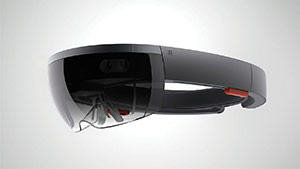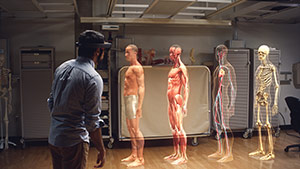launch
Reimagining Anatomy Education
During a presentation at Microsoft's Build conference in March, Case Western Reserve developers Henry Eastman (left) and Jeff Mlakar (right) examine a holographic image of the brain. The head behind them is an avatar of Radiology Professor Mark Griswold, who is guiding their 'learning' remotely.
At last, the hologram is real.
Nearly a year and a half after the leaders of Case Western Reserve and Cleveland Clinic first viewed the then top-secret Microsoft HoloLens device, the partners became the first outside entities to launch a HoloLens app in the Microsoft Store online.
But don't go rushing to the web to find the HoloAnatomy app; it won't appear on a regular computer screen or mobile device. Only those who have a Microsoft HoloLens device can see the icon in the online store or download the free app.
 COURTESY OF MICROSOFT
COURTESY OF MICROSOFTMicrosoft began shipping its HoloLens devices to thousands of developers on the first day of the 2016 Build conference. The company calls the device the world's first and only untethered holographic computer. Weighing about 11/4 pounds, the device includes 2 gigabytes of RAM and runs on Windows 10.
As those few on campus who've donned the device often attest, people can't fully appreciate the power of viewing the three-dimensional images until they actually experience it. Still, School of Medicine Dean Pamela B. Davis, MD, PhD, did her best to convey its potential during a live presentation this spring at Microsoft's annual Build conference.
Joined by university developers Jeff Mlakar and Henry Eastman on stage at San Francisco's Moscone Center, Dean Davis explained that the university and Cleveland Clinic intend to use the futuristic technology to teach anatomy in their new Health Education Campus, scheduled to open in the summer of 2019.
She started with a transparent, three-dimensional holographic body that had the organs of the digestive system represented within it, complete with labels for each one.
 COURTESY OF MICROSOFT
COURTESY OF MICROSOFTCase Western Reserve medical student Satyam Ghodasara looks at separate three-dimensional images of the human body using Microsoft HoloLens.
"Anatomy is all about mastering the complex systems in the body," Davis told a live audience of roughly 5,000 and an additional 300,000 people watching online. "As you can see ... there are a lot of parts in a small space."
So many parts, in fact, that the pancreas is difficult to find when viewing the front of the body; it is largely nestled behind the stomach. With a small hand gesture, Mlakar made the hologram spin 180 degrees, revealing the roughly 6-inch organ that assists with digestion and helps regulate blood sugar.
Then Case Western Reserve Radiology Professor Mark Griswold, PhD, joined the presentation as a virtual instructor. With representations of his head and hand floating in the air, he showed a holographic brain developed from an MRI scan of a patient in the lab of Biomedical Engineering Professor Cameron McIntyre, PhD (CWR '97, GRS '01). It also featured a hypothetical tumor pictured in red. With Griswold's guidance, Mlakar and Eastman examined the mass from multiple angles to determine which functions it might impair.
.jpg)
HoloAnatomy, the free demonstration app of how Microsoft HoloLens can be used to learn about organs and systems within the body, is the first app not from Microsoft to appear in the company's online store for applications using the HoloLens device. (These apps only can be used or even seen in the store when wearing a HoloLens device.)
"This is really changing what it means to be 'in class,'" said Griswold, faculty director for the university's Microsoft HoloLens project.
The Build presentation featured several of the images included in the HoloAnatomy app, which offers narration to guide the device wearer through an interactive tour of the digestive system and brain. In addition, the app shows how the HoloLens user could make hand gestures to illuminate different parts of the brain, or identify organs as though taking a virtual quiz.
Meanwhile, Griswold and his team are continuing to develop holographic modules for the anatomy curriculum students will experience in the Health Education Campus—and considering educational applications in disciplines across the university. As Mlakar said: "We've got some very smart people on it. ... [It] is an exciting time."





